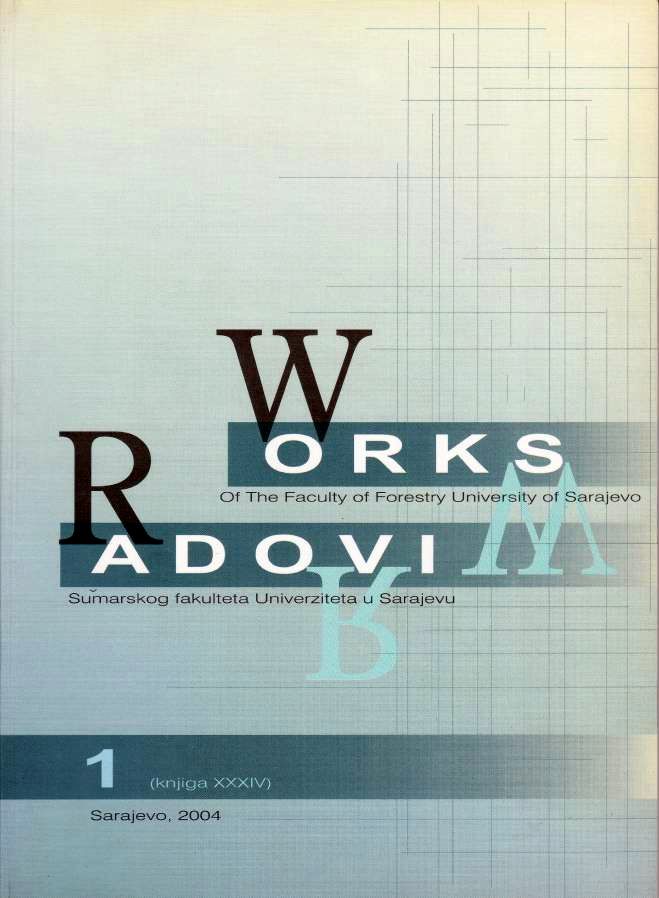The control of morphologic identification of the clones from the seed orchard of scots pine ''Koziji grm'' by using the isoenzyme markers
DOI:
https://doi.org/10.54652/rsf.2004.v34.i1.205Keywords:
clone, seed orchard, isoenzyme, identificationAbstract
UDK 630*232:582.475(497.6 Tarčin)
630*232:577.151.64(497.6 Tarčin)
This paper presents the possibility of molecular analysis and identification of the clone material from the seed plantations ''Koziji grm'' near Tarčin, as well as comparison with the former morphological analysis that has been carried out by using seeds.
On molecular level of the study with 9 enzyme systems with a total of 12 gene loci, that is, 52 allels which were registered in the clone seed plantation.
The obtained results in this study indicated that morphological analyses can only prove successful if the procedure in production of the clone material for raising clone plantations are fully respected, and there are no undesired genotypes. Also, the morphological methods are only acceptable in smaller clone seed plantations, with lesser number of clones, up to 20, covering the space of up to 1 ha, where the influence of the environment is minimal.
The molecular methods of clone identification in this case showed their simplicity and reliability, and they should find their place in the cases of raising clone seed plantations themselves.
In the clone seed plantation of Scots pine ''Koziji grm'' we found many more genotypes than anticipated by the project, which points at certain errors that were concisely or unconsciously done over the period of raising the clone seed plantation.
In order to avoid all possible dilemma about origin of the clones and to find the way out from the situation in which the clones mix, the best possible solution is in molecular analysis and identification of the clone seed material, as well as pre-analysis in the process of raising contemporary clone seed plantations.
The seed plantations allow for a very simple control of seed production. The molecular seed identification that originates from such seed material is facilitated and more successful because the genetic structure of the clone material is already known, which in other words means that produced seeds and planting material have already known genetic constitution. The identification itself, in this case, are far simpler than in the case of natural seed stands, where genetic structure can be changed from one year to another.
Certain dangers would, however, persist such as the possibility of hybridization with Scots pine from natural populations and raised cultures, but this is reduced to a minimum by proper choice of the location for the seed plantation.
Downloads
References
Ballian, D. (2003): Kontrola podrijetla sjemena i sadnog materijala pomoću izoenzimskih markera, Zbornik radova seminara: Stanje i perspektive proizvodnje sadnog materijala u rasadnicima Federacije Bosne i Hercegovine, Šumarski fakultet, Sarajevo, 18.12.2003.
Cheliak, W. M., Pitel, J. A., 1984: Techniques for starch gel electrophoresis of enzymes from forest tree species. Petawawa National Forestry Institute, Canada, 1-49.
Gregorius.H.R., Hattemer, H.H., Bergmann, F. 1984: Über Erreichtes und kaum Erreichbares bei der “Identifikation” forstlichen Vermehrungsguts; Bericht des Instituts für Forstgenetik und Forstpflanzenzüchtung der Georg- August-Universität Göttingen.
Hertel, H. 1997: Biochemisch-genetische Untersuchungen bei Kifer (Pinus sylvestris L.) – Anleitung zur Trennmethodik und Auswertung der Zymogramme. Mitteilungen der Bundesforschungsanstalt für Forst – und Holzwirtschaft Hamburg, Nr. 186.
Konnert, M., 1992: Genetic studies in damaged silver fir (Abies alba) stands in southwest Germany. Freiburg, Germany Mitteilungen der fortstlichen Versuch und forschungsanstalt Baden Wurttemberg, 167: str. 119 .
Konnert, M., 1995: Isoenzymunterschungen bei Fichte (Picea abies (L.) Karst.) und Weißtanne (Abies alba Mill.) – Anleitung zur Trennmethodik und Auswertung der Zymogramme, Teisendorf.
Konnert, M. 1999: Herkunftsüberprüfung mit biochemisch-genetisch Metoden; Der Weihnachtsbaum, No 5, pp 4-9, Gudensberg.
Mameledžija, J. 2002: Identifikacija klonova bijelog bora (Pinus sylvestris L.) po morfološkim karakteristikama sjemenki. Šumarski fakultet u Sarajevu, Diplomski rad, str. 27.
Silvertown, J. W., Doust, J. L., 1995: Introduction to plant population biology, Blackwell Science, Reprinted 1995, str 210.
Stefanović, V., Beus, V., Burlica, Č., Dizdarević, H., Vukorep, I., 1983: Ekološko-vegetacijska rejonizacija Bosne i Hercegovine, Sarajevo, 1983, Šumarski fakultet, Posebna izdanja br. 17, str. 51.
Tucović, A. 1990: Genetika sa oplemenjivanjem biljaka, univerzitet u Beogradu, str. 511.
Vidaković, M., Krstinić, A., 1985: Genetika i oplemenjivanje šumskog drveća, Sveučilište u Zagrebu, str. 503.
Wendel, J.F., Weeden, N. F., 1989: Visualization and Interpretation of Plant Isoenzymes. (ed.) Soltis, D.E., Soltis, P.S.: Isozymes in Plant Biology, London, 5- 45.






















